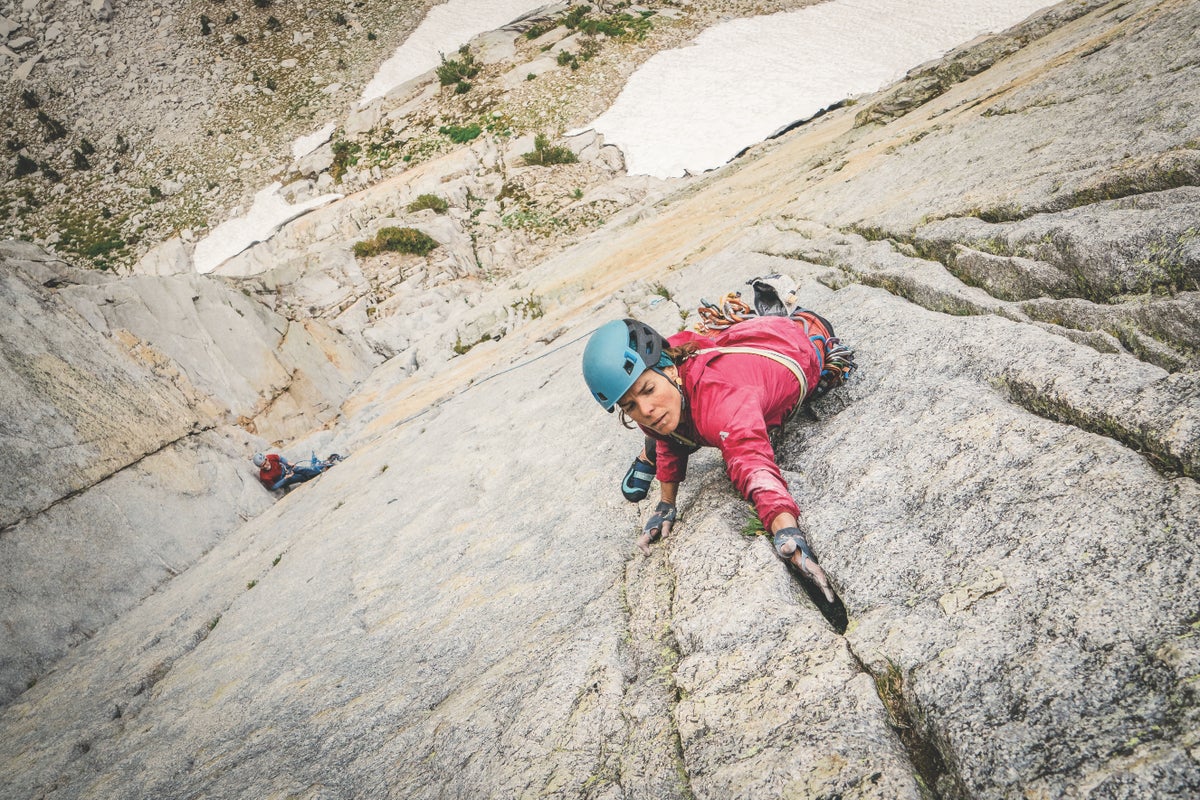
Deciphering the cryptic lore of the Sierra Nevada's remote, seldom-visited Citadel.
The post Bold Climbs and Dubious Pasts in the Eastern Sierra appeared first on Climbing.

This article was originally published in Climbing No. 373 under the title “Wild Kingdom.”
“Don’t kill your husband, don’t kill yourself.”
“Don’t kill your husband, don’t kill yourself.”
“Don’t kill your husband, don’t kill yourself.”
This mantra looped in my head as I led out on some of the worst stone I’ve encountered in my 24 years of climbing. One hundred feet off the belay and directly above my husband, Ben Ditto, I stemmed out across two refrigerator-sized blocks. We were high on the 1,700-foot nordwand of the 11,744-foot Citadel, a broad apron of granite that tapers to a striking pyramidal summit deep in the Sierra backcountry. The wall is shrouded in mystery, with only a handful of climbs on its flanks—perhaps it’s the rugged, 18-mile approach into Kings Canyon National Park that keeps suitors away. Or maybe it’s the variable rock quality.
I tried to discern the best path through the enormous stacked white Jenga blocks. Avoiding the larger choss meant making the climbing harder—this was a first ascent, so we were writing the rules as we went. Far below, the gigantic hemlocks, junipers, and foxtail pines in Ladder Lake Basin looked miniscule. While splitters cut their way through the lower part of the wall, providing incredible movement and exposure, this upper terrain—from about pitch 11 on up—was weathered to an extreme.
This wasn’t what I’d pictured during my three years of daydreaming since first spotting the wall. I’d imagined splitter pitches on impeccable rock, as if the Great Trango Tower itself rested within a day’s hike of our home in Bishop, California. But reality was proving otherwise.
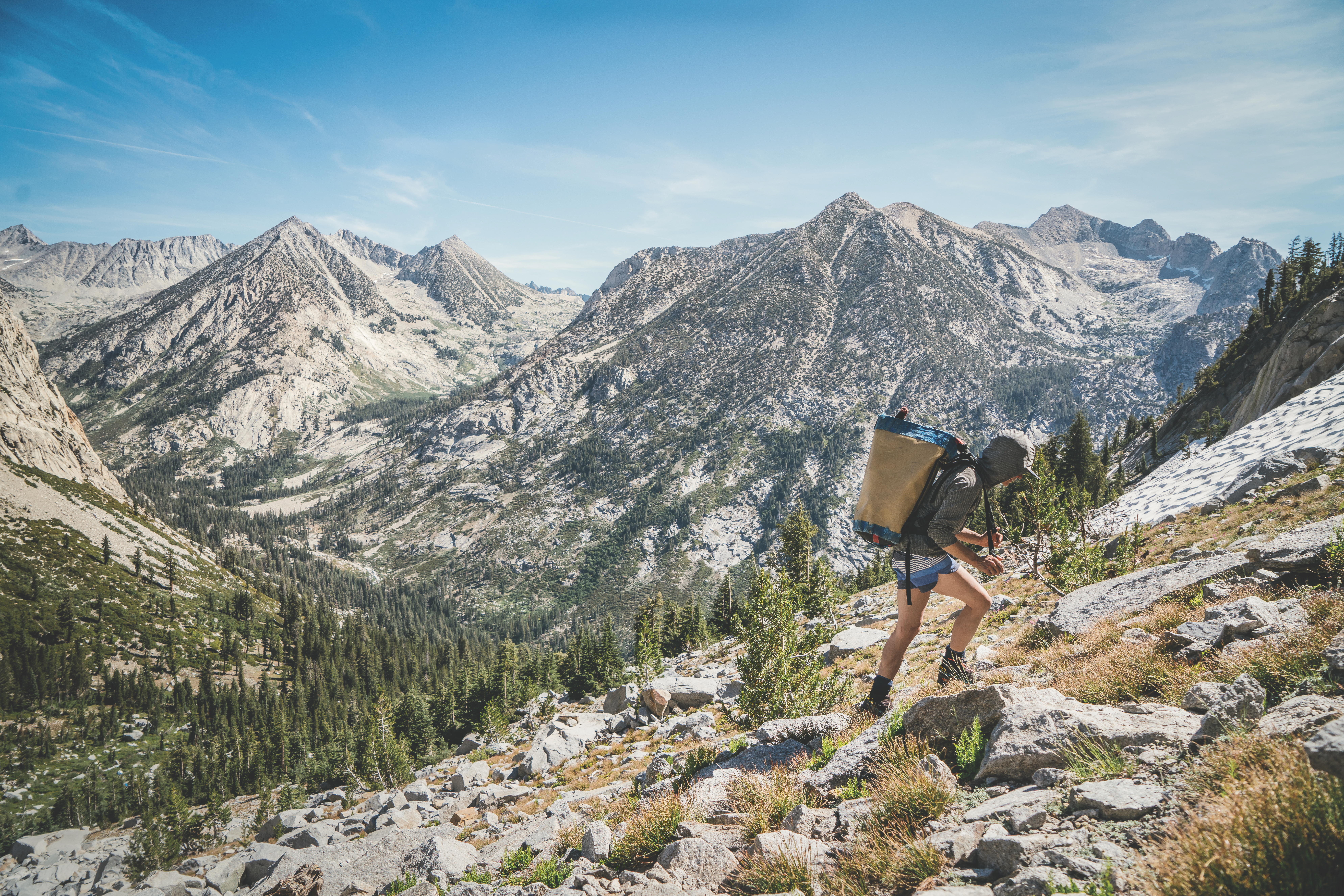
In August 2016, I’d been working a portering job through Sierra Mountain Guides for fast-packers out of Bishop. The clients were doing the classic 54-mile loop from South Lake to North Lake, carrying only fanny packs with lunch and water. Five of us porters took the rest, carrying cumbersome packs containing such luxury items as fuzzy slippers and a large salad bowl. Adhering to a strict schedule, we trudged along the 17 miles of steep, dusty trail from South Lake over Bishop Pass into Dusy Basin, dropping into LeConte Canyon and onto the John Muir Trail (JMT). This was my first time in this region, and I could hardly stay on trail as I gawked at the scenery. Nine miles in, the water-carved granite of Dusy Basin opened up to a striking black peak to the north.
“What is that? Has anybody climbed it?” I asked the other porters. One of the women quipped that “Surely someone had,” but no one knew what it was. I was anxious to get home and find out more.
According to RJ Secor’s The High Sierra: Peaks, Passes, Trails and Claude Fiddler’s Sierra Classics: 100 Best Climbs in the High Sierra, this dual-summited peak was the Citadel, home to seven known routes: West Ridge, Northwest Chute, Northwest Buttress, North Face, Edge of Time Arête, Nothing But Time, and Northeast Face. Sierra Club members established the first routes, the West Ridge (Class 2) and the Northeast Face (Class 4), on June 24, 1951. While one party hiked up the western edge of the mountain, the other climbed loose gullies and chutes to the east summit. We’d later find ourselves on summit day in the saddle between the summits, crossing over giant blocks of sheared-off granite, holding our breath so as not to dislodge anything. The description in the Secor book never alluded to anything off kilter, but then again it referred to an ascent made nearly 70 years earlier.
In 1968, the Citadel saw its first proper rock climb: the North Face (5.7 A3), established by the Yosemite hardmen TM Herbert, Don Lauria, and Dennis Hennick. I pored over my iPhone pictures of the wall, comparing them against the photo-topo in Secor’s book. I’d been attracted by a prominent dihedral system in the middle of the wall capped with tiered roofs—the 1968 route, per the guide. In the 1969 American Alpine Journal, Lauria wrote, “We chose the longest, most direct line leading to the east summit. The first day was spent climbing in a prominent dihedral”—likely that eye-catching corner system—“capped by some messy overhang.” After six pitches of moderate free climbing and three pitches with some aid, the climbers bivied on “the narrow, loose ledge that slants diagonally … across the entire north face.” Continued Lauria, “We reached the east summit early the next afternoon after scrambling up ten pitches of easy free climbing. A tiring traverse to the true summit, and the long descent past Ladder Lake left us facing the real challenge: the 18-mile hike back to the car.”

The Citadel would not see action again for two-plus decades. Over a blitzkrieg weekend in August 1991, the Sierra legend Dave Nettle and partner Jim Howle went in to free the North Face. Nettle had first become aware of the Citadel during a ski tour from Yosemite to Mount Whitney in the early 1980s. With decades of rock and alpine experience and numerous FAs of some of the Sierra’s hardest lines, it wouldn’t have been out of place for him to snag a single-push free ascent of the face.
They left Reno on Friday. By midnight, they’d started the approach, and were climbing by midmorning. Discarding their initial goal, the men instead went for a prominent cleaved arête on a buttress out left—as Nettle puts it, “Never mind the North Face. I was so mesmerized by the arête, that’s what we were obviously going to do.” An initial jumble of pitches led up to the edge, where the pair encountered spicy and variable climbing up the laser-cut arête for 1,000 feet to the east summit’s flank.
They topped out in late evening and, with “wimpy” headlamps, made the technical descent back to Ladder Lake Basin. On the “death march” out, Nettle lay down near the top of Bishop Pass to rest while he waited for Howle. He dozed off as he stared at the star-filled sky, jolted awake, and started hiking again; Nettle went about a mile before he realized he’d been hiking in the wrong direction. The men made it back to Reno just in time for Nettle to walk into Alpenglow Sports for work Sunday morning, having established the Sierra classic Edge of Time Arête (IV 5.10+).
* * *
For at least 7,000 years prior to the arrival of Europeans, original peoples—the Owens Valley Paiute, Western Mono (Monache), and Yokuts—traveled through and inhabited the Sierra Nevada, navigating via a network of foot trails. In the 1820s, hunters and trappers came into contact with these original inhabitants. While initial relations were “relatively” friendly, the newcomers soon brought conflict and strife. As the United States was becoming more developed, native peoples were pushed off their lands by such things as the Indian Removal Act of 1830. By the 1830s and ‘40s, disease swept through the native communities, and by the time of the massive Oregon Trail settler migrations (1840s to 1860s), conflict, bloodshed, and the taking of vast swaths of land had become commonplace. The Indian Appropriations Act of 1851, which allocated funds to move western tribes onto reservations, was passed. As a result, the Paiutes, Monache, and Yokuts were relocated from the lush Sierra farther south into the desert.
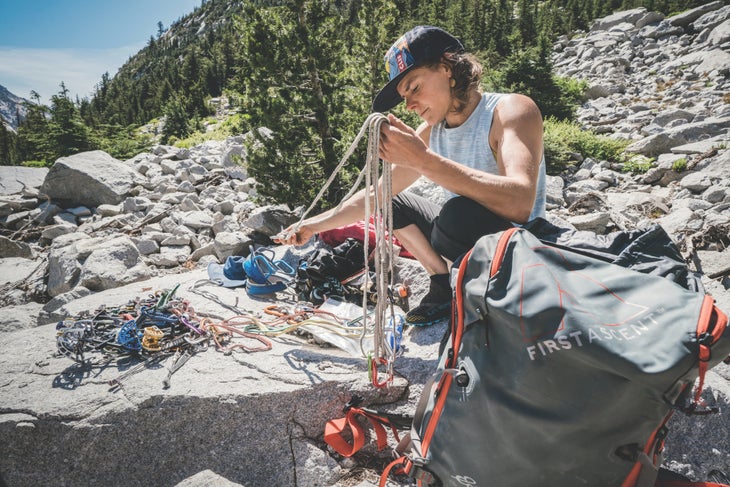
In 1892, the Sierra Club was founded, and John Muir, a longtime visitor to the Sierra today known for an increasingly problematic legacy of wilderness preservation, was elected its first president. Around 1902, the club took its first High Trips into Yosemite, Sequoia, and Kings Canyon. By 1909, the club advocated for more advanced trail construction. To that point, access had largely been via the Nüümü Poyo—the People’s Trail—an old Native American trade route. In a final act of cultural erasure, the trail would be given Muir’s name after his death, in 1914. (It took until 1938 to complete, with erosion control, steps, switchbacks, ranger stations, huts, and corrals added.) Today, the Nüümü Poyo is more famously known as the John Muir Trail, and thousands of permits are issued annually for the 213-mile trek from Yosemite Valley to Mount Whitney.
On August 20, 2019, Ben, Julie Ellison, a few porters, and I hiked into Kings Canyon National Park, a vast wilderness of rugged terrain with some of the steepest relief in North America. Our mini-expedition had come together thanks to funds from my sponsor Eddie Bauer. As we humped loads into the Citadel, we walked along the Nüümü Poyo. We crossed paths with several dozen people—JMT through-hikers, and others doing smaller loops. To them, our haulbags and overstuffed climbing packs must have looked odd. Some stopped to ask what we were doing. After eight hours of grinding, we camped along the Middle Fork of the Kings River, pitching our tents in a horse camp away from the JMT.
The next morning, our porters left us with a gigantic pile of climbing equipment, two tents, sleeping gear, and four bear canisters of food. We methodically split up the loads. We each made two carries along the thousand feet of elevation gain to Ladder Lake Basin. Here, we set up shop on a small, grassy outcrop riddled with wild onion and sky pilot, on a sandy bed away from the soggy outflow from Ladder Lake.

At camp, we studied the Citadel, quiet, foreboding, and painted with afternoon shadow. Our anticipated line looked better the closer we got. Splitters lined the face, leading up green-hued granite to large roofs and intriguing traverses. As we cooked dinner, the sun dipped behind Giraud Peak, casting an orange blaze over camp, our view a 360-degree panorama of the basin, the Palisades, Mount Shakespeare, the Black Divide, and—front and center—the Citadel. That night and each one after, we fell asleep cradled by the basin and the sound of rushing water.
The next morning as we sipped our coffee, we studied the wall.
With the completion of the JMT, Sierra Club members began to take more outings into the High Sierra. Trip leaders had gained knowledge of ropework from their time in the 10th Mountain Division in WWII, which allowed them to undertake more complex endeavors in the Sierra. The Yosemite masters who’d climbed the North Face had garnered this knowledge from their predecessors, going deep into the Sierra wilderness to apply their skills.
Our anticipated line seemed obvious, yet as we compared the wall to the guidebook, things began to not add up. Julie agreed that the dihedral system I’d picked seemed to match the book. The crux aid roof, according to Secor, came at 600 feet, one-third of the way up a distinct line on the photo-topo that followed the leftmost of three dihedral systems—all capped by overhangs. To its right, the book showed the 2001 Mike Pennings and Jimmy Hayden route Nothing But Time (5.10d), described as climbing through three parallel cracks in the most “obvious” overhang.
Ben looked from topo to rock several times before saying, “Is it just me, or are those three cracks way right of where this says they should be?”
I grabbed the topo. “Do you think this means the line-topo for the North Face is off, too?” I asked.
“The only way to know is to get right in it,” said Ben. “We’ll just have to climb up there and see.”
* * *
It was the summer of 1968 when the three Yosemite climbers established the North Face. The Vietnam war was raging, Martin Luther King Jr. and Robert F. Kennedy had been assassinated, the Memphis Sanitation Workers’ strike helped instigate the Civil Rights Movement, race riots raged, Lyndon Johnson signed the Civil Rights Act, the US became the first nation to orbit the moon and soon thereafter to land on it, the Cold War was in full swing, feminism was surging and Yale finally started to admit women, Boeing released the first 747, and Jimi Hendrix released Electric Ladyland. Still, amidst this unrest, TM Herbert, Don Lauria, and Dennis Hennick came to this quiet basin to climb. What was it about their lives that afforded them this luxury?
In 2019, the year of our climb, the divisive Trump Administration diverted “emergency” funds to construct a border wall between the US and Mexico and immigrants were being detained indefinitely, with children separated from their parents, white supremacy was ascendant, there were mass shootings, the Keystone pipeline was approved, Alabama and Louisiana made it illegal to terminate a pregnancy after six weeks, the opioid epidemic reached astounding proportions, the climate crisis worsened with ever-more-virulent floods, droughts, and fires, tensions between the US and North Korea and the US and Iran flared, and a fleet of Boeing 737 Max airplanes was grounded after two fatal crashes. And yet here we were, climbing on the Citadel as well. What was it about our lives that let us do the same during a turbulent year much like 1968?
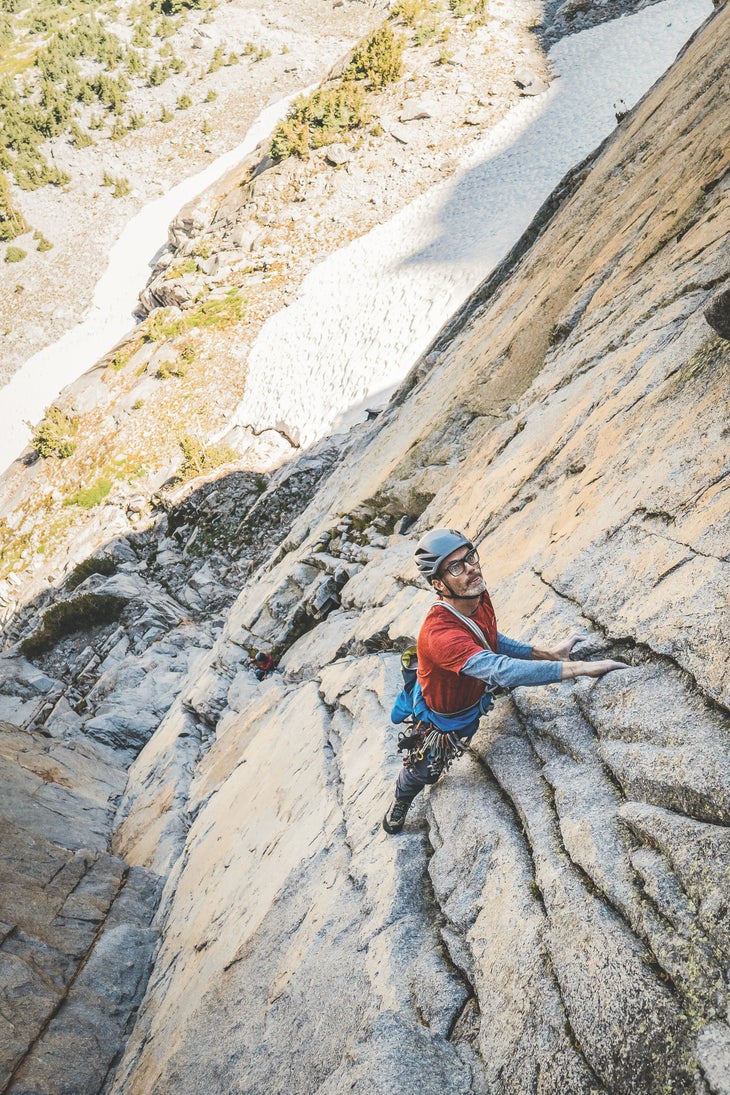
I don’t have an easy answer—maybe climbing has always just been escapism. But I also know that, as climbers, these places bring us happiness, a disconnect from the buzz of modern life. The world will never be at peace, I’ve come to realize, so we may as well climb—then, at least, we can seek balance and perhaps re-enter society better equipped to help solve, or at least not worsen, its never-ending litany of problems.
As we approached the wall, the rock lightened, revealing amphibole grains, green granite, and a hint of lichen—fairly clean, solid, and featured. My eyes remained drawn to the enormous white roof 600 feet up the leftmost dihedral. This line, which I assumed to be the North Face, would be our route. Ben and I got to work, spending the next two days preparing the first four pitches.
Day 1: Pitch one followed a series of three cracks up smooth white granite, and then moved over a small roof onto incipient cracks to a ledge. The gear was subpar, the initial climbing maybe 5.9. From the ledge, a slick dihedral leaned up and gently right; parallel cracks sliced left. With some nut-tool cleaning, I’d be able to place small brassies in the corner, but unfortunately, I didn’t have the tool on hand. I climbed down, built an anchor below the ledge, fixed the rope, and rapped.
Day 2: We Mini Traxioned up to our high point, and nut tool in hand I continued up the thin corner. Holding stemmed-out positions, I dug eons’ worth of dirt from the crack, finding a placement just large enough for a No. 2 brassy. Above, I scraped dirt to place another wire, surging into more slick, technical climbing. The 70-meter pitch went at 5.11 R. I’d been expecting to see a relic from the FA, but we found no such treasure.
Ben led out a flaring roof, stemming through dirt and exfoliating rock to a pinch crack. “Watch your eyes,” he hollered at an exposed pull onto the face above. “Dirt’s coming down—you’re going to have to re-find those footholds now.” He ended this 5.10c pitch at an obvious stance. Continuing farther left into the middle of a few cracks, I led out on more vegetated terrain, cleaning on lead, the dirt pouring onto my footholds. I continued up past two big roofs to a belay below the third tiered roof in a dihedral. Another 5.10c pitch and still no sign of the 1968 climbers.
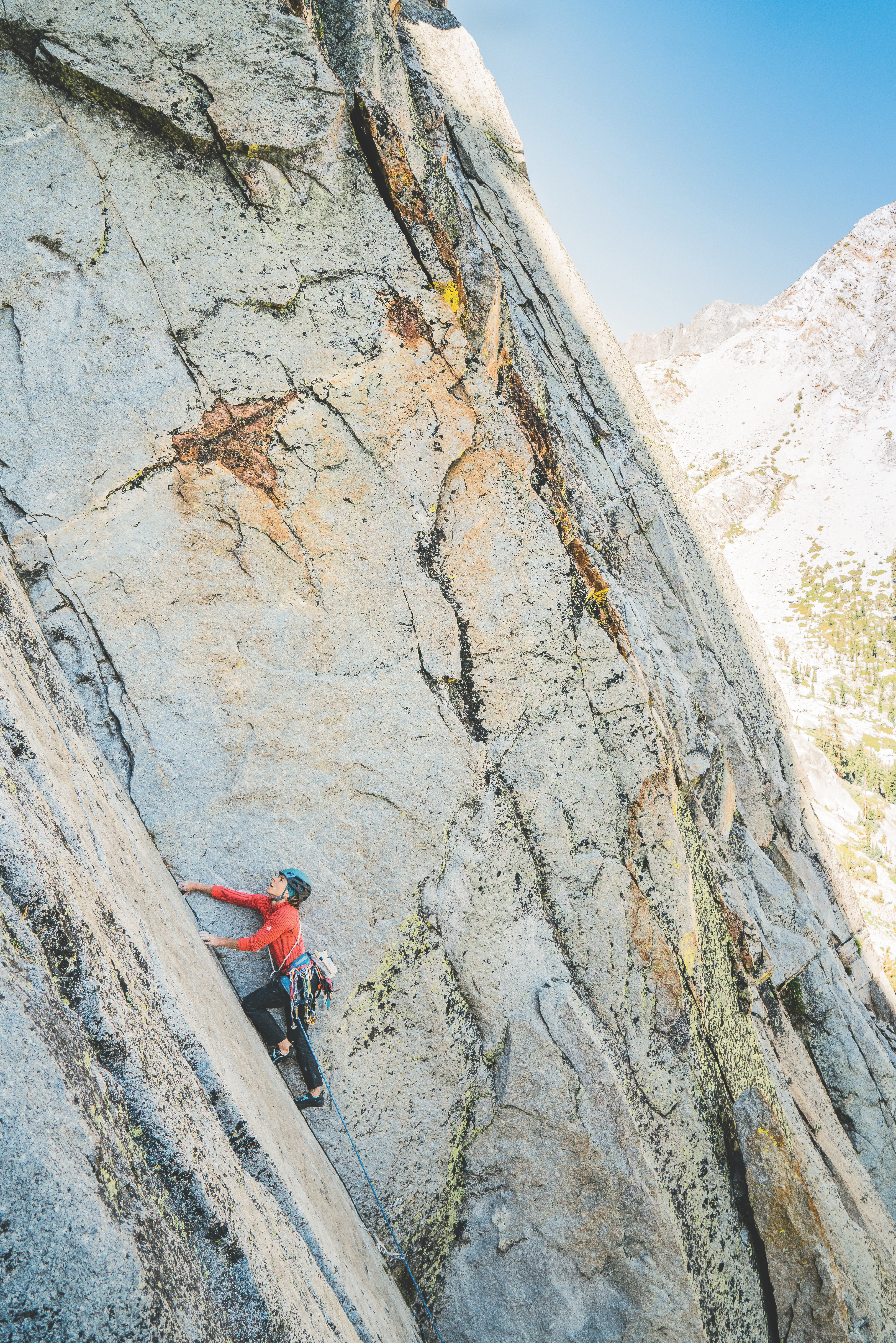
On the fourth pitch, wide double cracks led up a large, left-facing dihedral. Ben stopped at a ramp below overhanging flakes. The crack tapered out above, going from thin to nonexistent. We’d arrived at the huge white roof; it looked like we’d have to bypass it via runout face climbing, which continued up and out of sight after a final, smaller roof.
* * *
On our day off, we hiked around the basin. Scree shifted underfoot as we picked our way through the alpine benches of gooseberry and pine toward the waterfall of Ladder Lake. The grinding of rock on rock was such a familiar sound to me that the subtlest change in its pitch—a hollow, metallic ringing—caught my attention.
I looked down and saw that I was standing on a tarnished bullet casing. I stooped to pick up the coarse relic, then twirled the rifle shell in my fingers—the head stamp was marked with the initials REM UMC, for the ammunition makers Union Metallic Cartridge Company and Remington. This rifle casing could have come from the days (1891–1913) when the cavalry “protected” this land. It was perhaps an artifact of the dark period when settlers drove out the Native Americans.
Back then, the settlers forged into the West, looking for their own way of life and the resources to support it. The miners and trappers needed food, thus ranchers came next. For nearly 40 years, sheepherders, ranchers, cowboys, miners, loggers, and adventurers traipsed through the Sierra unregulated. In 1888, this part of the Sierra fell under the jurisdiction of Sequoia National Park. Until 1916, the responsibility of managing and developing it as such rested with the US Army, more specifically the African American Buffalo Soldiers. These soldiers, the descendants of enslaved Africans, served on the Western frontier “as a strategy to obtain equal rights as citizens. Paradoxically, they sought to achieve this by engaging in government-led wars meant to overtake the Southwest and Great Plains from Native Americans,” according to the National Museum of African American History and Culture.
As Native American culture was erased and the sins of slavery were slowly swept under the carpet, Americans started to appreciate the mountains for their beauty rather than just their resources. This philosophy of wilderness appreciation was—and remains—a tense juxtaposition of the corrupted and the sublime. As we stood amongst the columbine and wild iris, bathed in the snowmelt of the creek, I came to the sickening realization that Julie, Ben, and I were an inextricable part of this bloody history, one that remains far from settled. It was also this history that gave us the luxury to step away from society and into these wild places.
Still, there was consolation in the fact that the cycle of life had been going on here since time immemorial, irrespective of man and his doings. You could see the passage of time in the environment: It was bursting with life—wildflowers, krumholz, deer, pikas and marmots playing in the talus—and yet also showed signs of the extreme changes wrought by rockfall, avalanche, and erosion. I’d experienced no other place that felt so directly connected to the earth’s primordial rhythm.

The next morning, with the buzz of the alarm at 5 a.m., we hurriedly donned our climbing attire and unzipped the tent door. Julie was up brewing coffee and mixing oats and powdered goat milk. She planned on shooting us from across the way as we climbed.
Ben and I were Mini Traxioning back to our high point by 7 a.m., leaving our ropes in place to return a few days later to take photos. By 9 a.m., we were starting on pitch five, which was my lead. My primary piece for the first 30 feet was a shallow offset No. 1 stopper slotted vertically, with just the outside top tips touching the rock. Perhaps it could have held my 100 pounds in a fall, but certainly no more than that.
I tiptoed across a featured face into a powerful layback, 30 feet out on that nut, smearing my feet close to my face. The rope arced loosely through space to Ben at the belay, a small ledge to his right that I’d likely hit if I fell. I ended the pitch at a stance below a right-leaning undercling, less than 40 feet below the giant white roof. If we were on the North Face, we were finally at its crux, though I still had yet to see a single fixed pin or tat. It seemed doubtful that the 1968 climbers had gone this way.
Ben led out the undercling, which took exceptional gear and moved along a dihedral before traversing around an arête. The next three pitches consistently presented more no-fall scenarios, with potential ledge falls, sparse gear, and what had become the route’s trademark blend of impeccable and terrible stone. I led one of the most dangerous pitches of my career, up a rotten, block-filled offwidth to a ledge covered in choss. With Ben directly below me, I could almost see the bullseye on his face. We went on this way, swapping leads, cleaning out placements and holds, sidestepping loose blocks like art thieves prowling the Louvre.
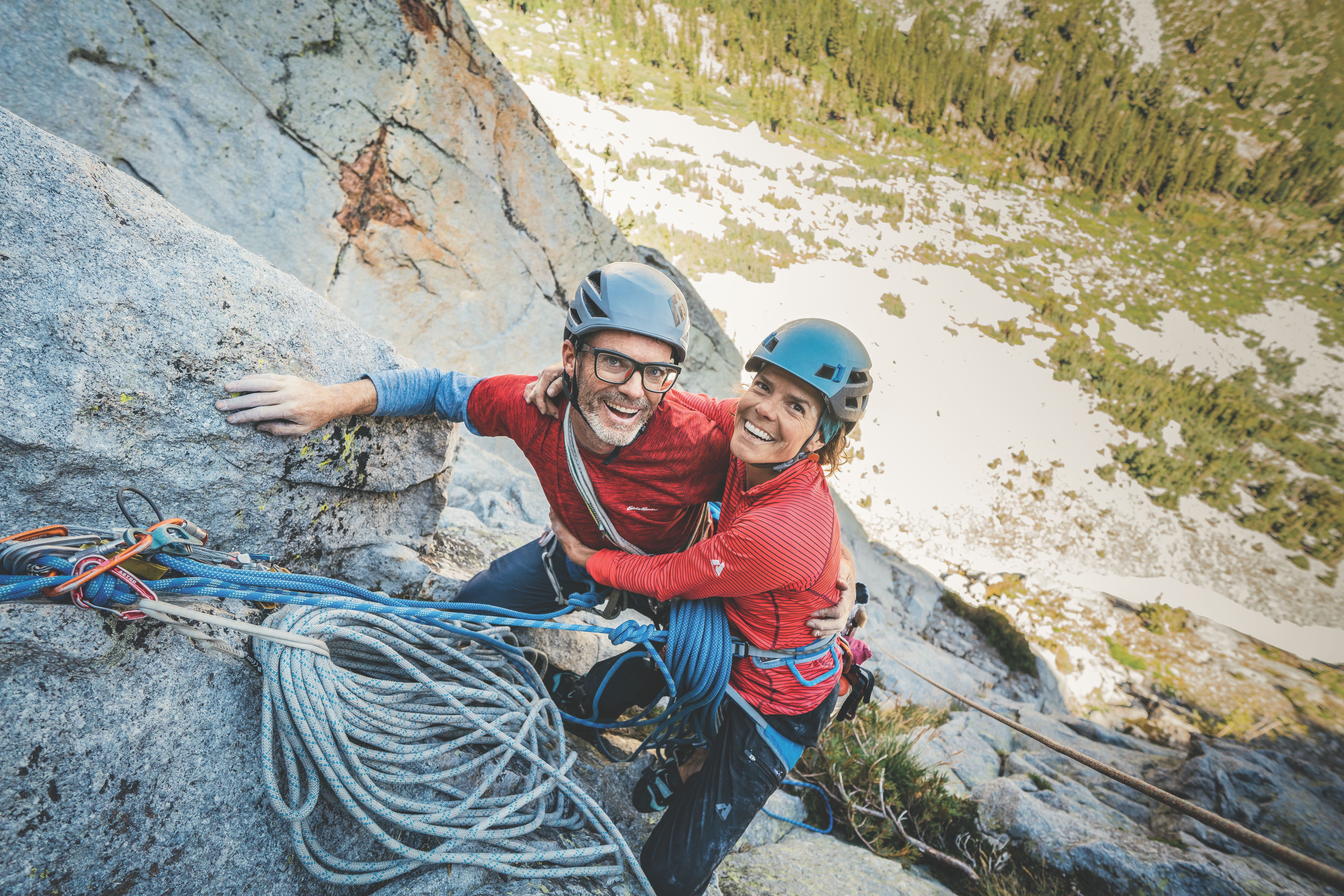
Pitch 10, Ben’s lead, was spectacular, with consistently solid rock and thoughtful 5.11 climbing. Above that, things literally fell apart, comprising 500 feet of some of the most deteriorated, slow-going, precarious, and heads-up climbing of our lives. On my leads, I could feel Ben’s tension at the bottom of the rope. As Ben—a non-believer—later told me, he’d prayed for the first time in his life as I navigated the white, decomposing tunnel of choss 1,200 feet off the deck. My time belaying was equally as worrisome. We topped out on the east summit around 6 p.m., having somehow avoided trundling ourselves off the Citadel. By 11 p.m. we were back in camp, where Julie greeted us with a pot of hot coconut-paste curry with freeze-dried beef, dehydrated veggies, and rice noodles.
We’d climbed 16 pitches that day, the route clocking in at 1,700 feet of 5.11 R. It hadn’t been the splitter climbing I’d pictured. Instead, amidst the gems of pinchy granite tufas, bottomed-out cracks, and technical dihedrals, there had also been terrain that was very stressful, uncertain, and dangerous. The route required steadiness of the mind—the specter of a serious accident or even death was often close at hand. I remain fairly certain we didn’t free the original North Face, but instead put up a new climb, which Ben and I named Wild Kingdom. But really, who knows?
Many parties have entered Ladder Creek Basin to free the North Face, but all ended up establishing a new route. The North Face remains shrouded in mystery, a recursive tale of would-be conquest that might never be resolved in the face of the Citadel’s crumbling northern wall—the spirit of the stone. That vast, untamable spirit is what native people, as well as we later visitors, have always been connected to, and what John Muir, like all Sierra climbers, also sought in the Range of Light.
I recently spoke with Dave Nettle about his time at the Citadel. He told me that RJ Secor, never one for topos, asked Nettle to draw a line on the photo showing where he thought the North Face party had gone. Turns out Nettle himself speculated, as no one from the FA party could recall anything about which dihedral they’d climbed. As Nettle told me this, I imagined a frayed, sun-bleached piece of tat dangling in the wind on the apex of the rightmost dihedral system, a relic of a bygone era—like a shard of chiseled obsidian kicked to the surface by a hiker on the Nüümü Poyo, waiting to be discovered by the next adventurer to cross its path.
Katie Lambert is a professional climber based out of Bishop, California, where she and her husband, Ben Ditto, own and operate Bishop CoWork. Her résumé includes first ascents in Yosemite, the Eastern Sierra, and the Cirque of the Unclimbables.
The post Bold Climbs and Dubious Pasts in the Eastern Sierra appeared first on Climbing.